Understanding (N)3GHSSYCY Cables
(N)3GHSSYCY cables represent a specialized category of power and control cables that play a crucial role in modern industrial applications, particularly in challenging environments. These robust cables are engineered to deliver reliable power transmission and communication capabilities in some of the most demanding operational settings. The importance of these cables in mining and tunneling operations cannot be overstated. In environments where safety, reliability, and durability are paramount, (N)3GHSSYCY cables provide the essential infrastructure that powers critical equipment and enables communication systems to function effectively. Their specialized construction makes them ideally suited for applications where conventional cables would quickly deteriorate or pose safety risks.
5/21/20256 min read

Understanding (N)3GHSSYCY Cables
I. Introduction
(N)3GHSSYCY cables represent a specialized category of power and control cables that play a crucial role in modern industrial applications, particularly in challenging environments. These robust cables are engineered to deliver reliable power transmission and communication capabilities in some of the most demanding operational settings.
The importance of these cables in mining and tunneling operations cannot be overstated. In environments where safety, reliability, and durability are paramount, (N)3GHSSYCY cables provide the essential infrastructure that powers critical equipment and enables communication systems to function effectively. Their specialized construction makes them ideally suited for applications where conventional cables would quickly deteriorate or pose safety risks.
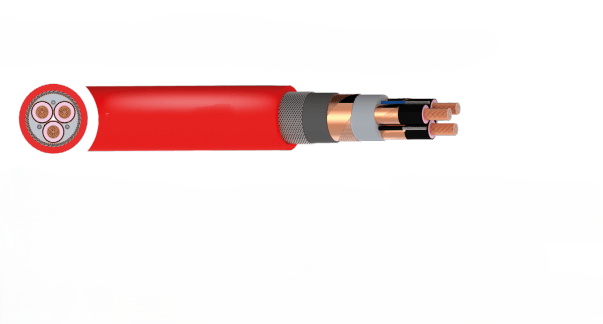

II. Applications of (N)3GHSSYCY Cables
One of the primary applications of (N)3GHSSYCY cables is connecting mobile operating equipment in mines and underground excavations with hazardous environments. In these settings, the cables must withstand continuous movement, flexing, and mechanical stress while maintaining electrical integrity. Mining equipment such as continuous miners, longwall shearers, and shuttle cars all rely on these specialized cables to operate safely and efficiently in environments where dust, moisture, and corrosive elements are common challenges.
Beyond mobile applications, these cables are also extensively used in stationary installations, such as high-voltage transformers in mining and tunneling operations. Their robust construction provides the necessary protection for power delivery systems that must operate continuously in harsh conditions.
A key advantage of (N)3GHSSYCY cables is their suitability for both indoor and outdoor installations. This versatility makes them an ideal choice for comprehensive mining and tunneling operations where cables must traverse various environmental zones. Whether installed in underground shafts, processing facilities, or outdoor connection points, these cables maintain their performance characteristics across diverse operating conditions.
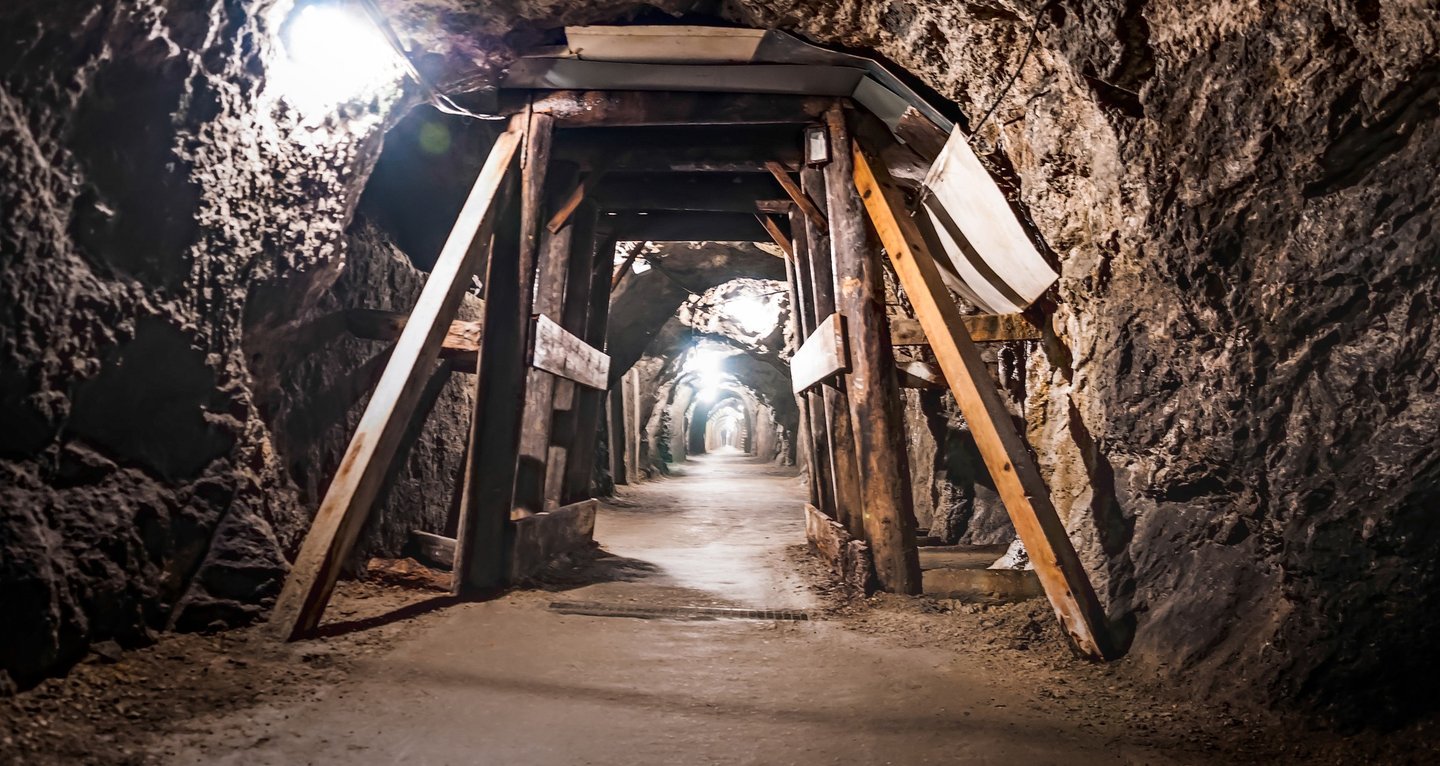

III. Electrical Parameters
Rated Voltage
(N)3GHSSYCY cables are available in multiple voltage ratings to accommodate different power requirements. The standard options include:
3.6/6 kV for lower power applications
6/10 kV for medium power requirements
8.7/15 kV for higher capacity systems
12/20 kV for heavy industrial applications
18/30 kV for the most demanding power transmission needs
Test Voltage
The test voltage for these cables ranges from 11 kV to 43 kV, depending on the rated voltage. This parameter ensures that the cables can handle temporary overvoltage conditions without failure.
Maximum Permissible Operating Voltage
These cables are designed to operate safely under different electrical conditions:
In AC applications: Up to 20.8/36 kV
In DC applications: Up to 27/54 kV
This dual capability makes them suitable for both traditional AC power systems and increasingly common DC applications in modern mining equipment.
Temperature Range
The operational temperature parameters demonstrate the robustness of these cables:
Fixed installation applications: -40°C to +80°C
Mobile applications: +5°C to +80°C
This wide temperature range ensures reliable performance across varying environmental conditions, from the cold depths of underground mines to the heat generated by heavy machinery.
Mechanical Properties
The mechanical specifications highlight the durability of these cables:
Maximum tensile load: 20 N/mm²
Maximum torsion: 25°/m
Maximum trawl speed for tunneling applications: 30 m/min
These properties allow the cables to withstand the physical stresses associated with mining and tunneling operations, including pulling forces during installation and operational movement.
CURRENT CARRYING CAPACITY
VOLTAGE DROP

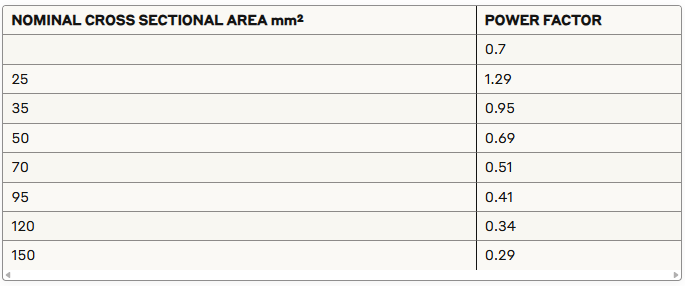

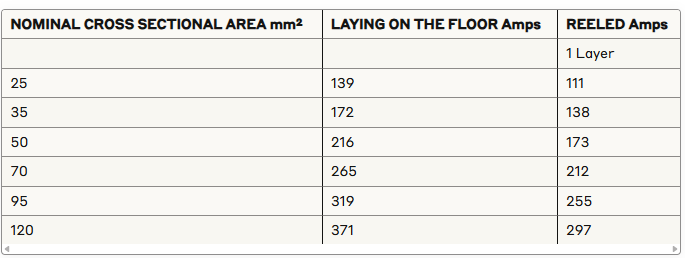

VOLTAGE DROP
IV. Construction Details
The superior performance of (N)3GHSSYCY cables stems from their sophisticated multi-layer construction:
Conductor
At the core of these cables is a flexible stranded copper wire, manufactured to Class 5 specifications according to DIN VDE 0295. This construction provides excellent flexibility while maintaining the necessary current-carrying capacity.
Insulation
The conductor is wrapped in an EPR (Ethylene Propylene Rubber) compound type 3GI3. This high-performance insulation material provides excellent electrical properties while remaining flexible and resistant to environmental factors.
Electrical Field Control
Inner and outer semiconductive rubber layers provide crucial electrical field control. These layers help distribute electrical stress evenly throughout the insulation, preventing hotspots and extending cable life.
Protective Conductor
Plain copper wires or copper wire braiding are laid up concentrically around each main core. This arrangement ensures effective grounding and protection against electrical faults.
Pilot Control Cores
The cables include black colored and number coded pilot control cores. These enable monitoring and control functions for connected equipment, allowing for remote operation and status feedback.
Inner Sheath
A PVC compound type YM5 forms the inner sheath. This layer provides additional protection against mechanical damage and helps maintain the structural integrity of the cable.
Monitoring Conductor
A semiconductive tape with an overall concentric lay of copper wires and synthetic tape over the wires serves as the monitoring conductor. This specialized component enables continuous monitoring of cable integrity and can detect damage or deterioration before catastrophic failure occurs.
Armour
Galvanized steel wire braiding with a minimum 75% coverage provides robust mechanical protection. This armoring helps the cable withstand the abrasion, crushing forces, and impacts common in mining and tunneling environments.
Outer Sheath
The final layer consists of a PVC compound type DMV6, available in red or black. This outer sheath provides the first line of defense against environmental factors such as moisture, chemicals, and abrasion.


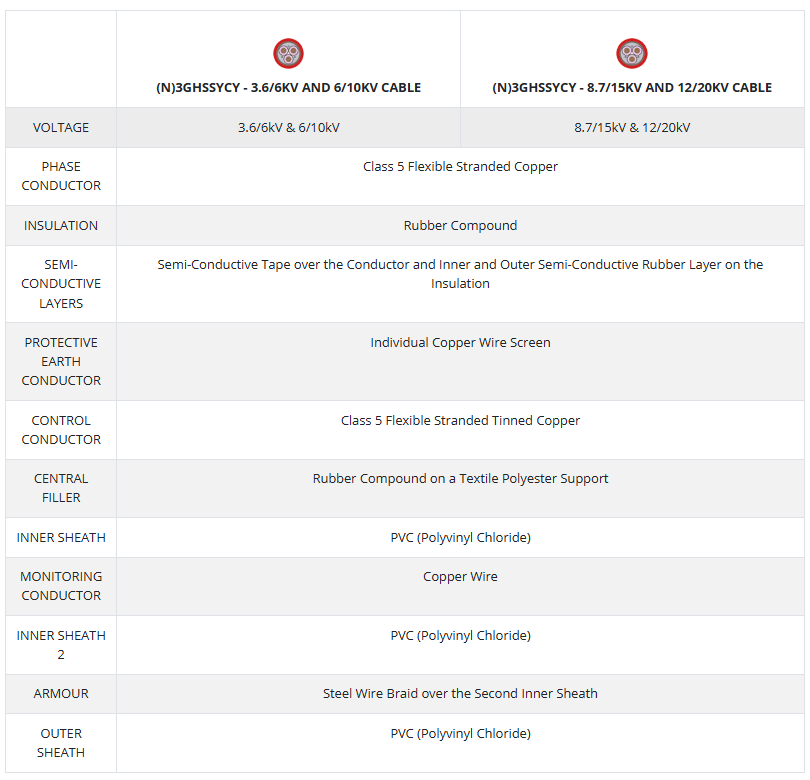

V. Frequently Asked Questions (FAQ)
Q1: What makes (N)3GHSSYCY cables suitable for hazardous mining environments?
A: These cables are designed with robust insulation and shielding to withstand mechanical stress, moisture, and chemical exposure. Their construction ensures reliable performance in underground and hazardous conditions. The multiple protective layers work together to create a durable cable that can maintain electrical integrity even when subjected to the harsh realities of mining operations. The semiconductive layers and copper wire shielding also provide effective protection against electromagnetic interference, which is crucial in environments where monitoring and control systems must function reliably.
Q2: Can these cables be used for both stationary and mobile equipment?
A: Yes, (N)3GHSSYCY cables are versatile and can be used for connecting both stationary equipment like transformers and mobile operating equipment in mining and tunneling applications. Their flexible construction and robust protective features make them suitable for applications where movement and flexing occur regularly, while their excellent electrical properties ensure they perform equally well in fixed installations. This versatility reduces the complexity of cable inventory management and simplifies installation planning.
Q3: What standards do (N)3GHSSYCY cables comply with?
A: They are manufactured in accordance with standards such as DIN VDE 0250-605, IEC 60502-2, and DIN VDE 0298-3, ensuring quality and safety in their applications. These international standards govern the design, testing, and performance requirements for cables used in hazardous environments, providing users with confidence in the cable's reliability and safety characteristics. Compliance with these standards means the cables have undergone rigorous testing to verify their performance under various stress conditions.
Q4: How do these cables handle fire hazards?
A: (N)3GHSSYCY cables are flame retardant, complying with standards like VDE 0482-332-1-2 and IEC 60332-1-2, which helps prevent the spread of fire in case of ignition. This characteristic is particularly important in underground applications where fire can quickly become catastrophic. The flame-retardant properties of these cables provide valuable time for evacuation and firefighting efforts in the event of an emergency, contributing significantly to overall safety in mining operations.
Q5: Are there specific installation guidelines for these cables?
A: Yes, installation should consider factors like minimum bending radius, maximum tensile load, and environmental conditions. For example, the minimum distance for a change of direction is 20 times the cable diameter. Proper installation is crucial for ensuring the longevity and performance of these cables. Factors such as avoiding sharp bends, proper support to prevent excessive tension, and appropriate termination techniques all contribute to reliable cable performance. Following manufacturer guidelines for installation helps prevent damage during the installation process and ensures optimal performance throughout the cable's service life.


VI. Conclusion
(N)3GHSSYCY cables represent a critical component in the infrastructure of modern mining and tunneling operations. Their specialized construction, combining flexible copper conductors, high-performance insulation, multiple protective layers, and robust outer armor, enables them to deliver reliable power and control capabilities in environments where conventional cables would quickly fail.
The comprehensive specifications detailed in this guide highlight the engineering considerations that have gone into the design of these cables. From electrical parameters that ensure safe and efficient power transmission to mechanical properties that withstand the physical stresses of industrial applications, every aspect of these cables has been optimized for performance in challenging conditions.
The versatility of (N)3GHSSYCY cables makes them suitable for a wide range of applications within mining and tunneling operations. Whether powering mobile equipment that must move throughout a mining complex or providing stable connections for stationary infrastructure, these cables deliver consistent performance that operators can rely on.
As mining and tunneling operations continue to advance technologically, the importance of reliable power and control infrastructure becomes increasingly critical. (N)3GHSSYCY cables provide this foundation, enabling safer, more efficient, and more productive operations in some of the world's most challenging working environments.
